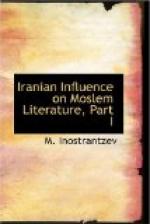[Footnote 3: Hoffmann “Extracts from Syrian acts of Persian martyrs”, 1880 page 289 note, and Justi, Namenbuch 186.]
[Footnote 4: Precise information regarding its contents is rather to be found in Ibn al Qifti than in the Fihrist. In the former the heading is Fi taat us Sultan, in the latter Fi rasail. See La perle incomparable ou l’art du parfait courtisane de Abdallah ibn al-Muqaffa, 1906. See the French translation from the Dutch rendering of this tract.]
[Footnote 5: On the political ideas of the latter see Pizzi, Le idee politiche di Nizam-ul-Mulk G.S.A. 1., 131-141.]
[Footnote 6: Tabari “Annales” Vol. 3, 1309, 9-15, and Browne A literary History of Persia, 1, 332.]
Besides Muqaffa a number of writers of the epoch of the development of Arabic Musalman literature interested themselves in themes connected with Persian antiquities. One of them, Aban Ibn Abdul Humiad ar Rakashi otherwise known as Aban al-Lahiki chose a number of themes from ancient Persian literature and according to the Fihrist versified them (119, 1-6-163, 7-10). Such subjects were—Kalila and Dimna, the Book of Barlaam and Yuasef, the Book of Sindbad, the Book of Mazdak and finally books on two popular representative of the Sasanian dynasty, namely, the Book of the acts of Ardasher and the Book of the acts of Anushirvan.[1]
[Footnote 1: Versification of the history of Anushirvan is also to be met with in later Parsi literature, see, Sachau, Contribution to the knowledge of the Parsi literature, J.R.A.S. 1870 page 258.]
Another author, Ahmed Ibn Tahir Taifur, wrote according the Fihrist (146, 21) a special Book of Hormuz son of Kisra Anushirvan.[1] No doubt, further more, writers of Persian origin followed in their books on Adab Persian models. Such probably was the book of Adab by an author whose name has been mutilated in the Fihrist (139, 15, 18). There is another class of writings which bears relation to this one and which is mentioned in the Fihrist. It is quite possible that on this literary Persian tradition, were based also some of the tracts under the title of “Books on counsels” a considerable number of which we meet with in the Fihrist.[2]
[Footnote 1: See the essay of Baron Rosen on the anthology of Ahmed Ibn Abi Tahir.]
[Footnote 2: 78, 15; 105, 10; 293, 12; 204, 17-18; 204, 29; 207, 21; 210, 23; 212, 22-23; 217, 4-5; 220, 25; 222, 14; 234, 23; 281, 20; 282, 5.]
Ethico-didactical treatises in the form of counsels, maxima or testaments, constitute a singular group of literary mementos the genesis of which in the Musalman literature maybe established only after an examination of similar books in the Persian writings of the Sasanian times. Examples of a like class of testaments, literary compilations under the title, for the most part, of pseudo-graphs going up to pre-Moslem period we have already noticed in the Book of the counsels of Ardasher and the Pand Nameh of Kisra Anushirvan.




